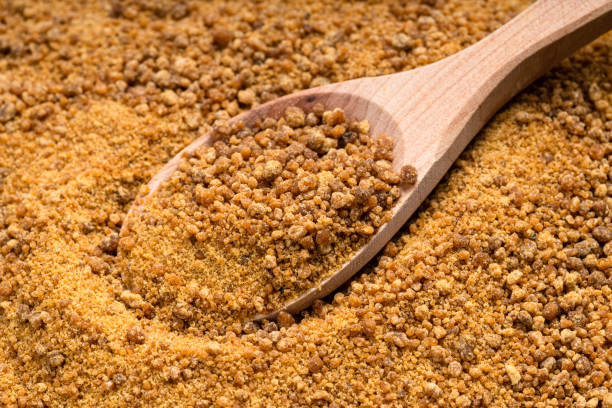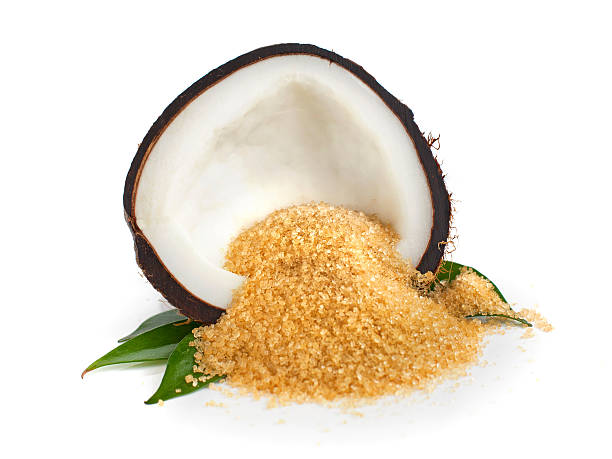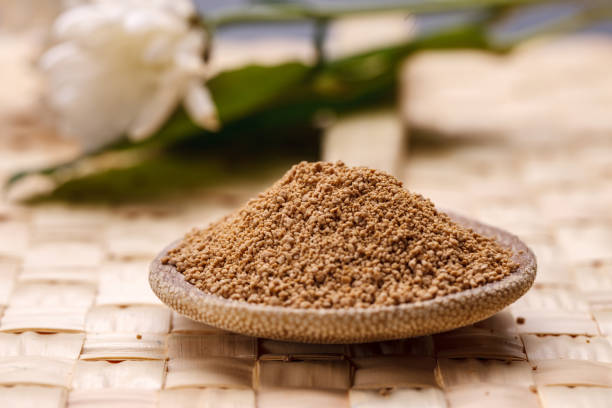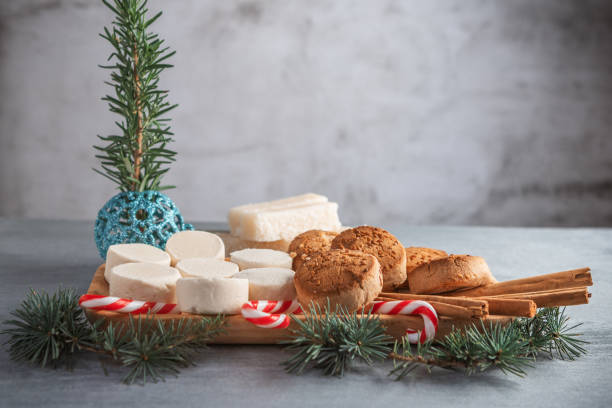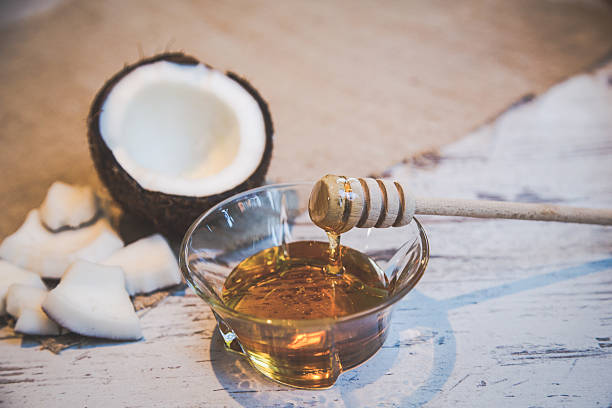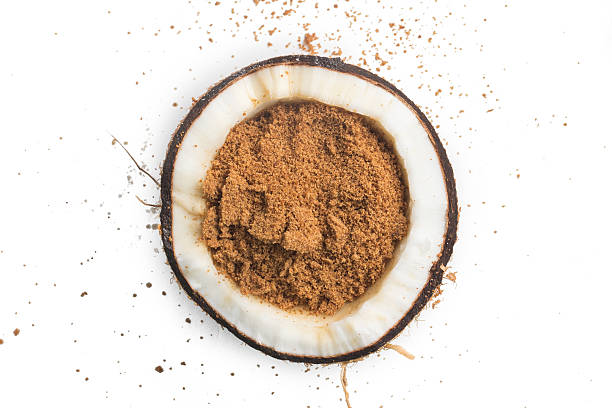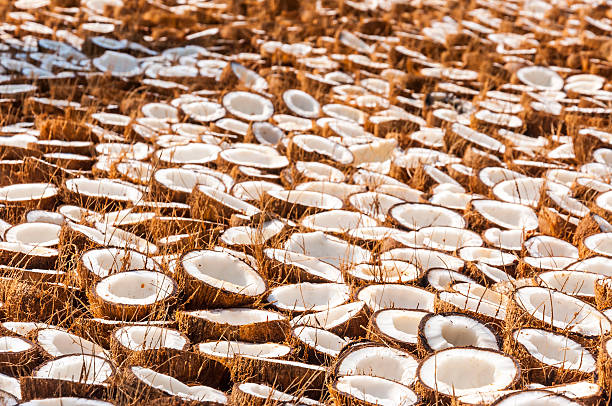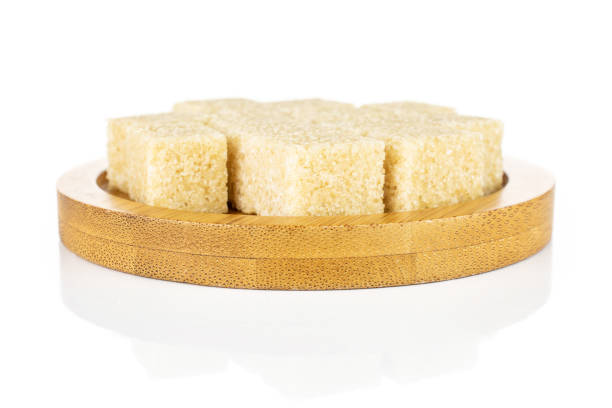Coconut sugar substitutes are Light brown sugar, Sucanat, Maple syrup, Date sugar, Maple sugar, Raw honey, Stevia, Agave nectar, and Piloncillo. Light brown sugar, dark brown sugar, and granulated sugar are the finest coconut sugar substitutes and can be used in equal amounts. Raw honey, maple syrup, and sucanat are the best natural Coconut sugar substitutes. Sugar obtained from the coconut palm tree is known as coconut sugar.

 What is Coconut Sugar?
What is Coconut Sugar?
Coconut sugar is manufactured from the sap of coconut palm tree blooms and is also known as coconut palm sugar, coco sap sugar, or coconut crystals. It’s an unprocessed natural sugar, especially when compared to granulated white sugar or ‘table sugar.’ Coconut sugar and coconut palm sugar are frequent names for this sugar, however, it is not to be confused with palm sugar. Palm sugar is a type of sugar derived from palm trees.
Making coconut sugar is a straightforward two-step procedure that begins with collecting sap from coconut flowers and ends with dehydrating the liquid. This dehydrated state is broken down into the coconut sugar granules that we buy. Its glycemic index is lower than that of granulated sugar. Given the similar calorie content, this isn’t a low-calorie option.
Still, the relatively raw sugar contains inulin, a fiber that aids in sugar absorption. Because of its low GI and trace mineral content, this sugar is a good option for a healthier diet. Coconut sugar is also available in liquid form, which adds to the confusion. Coconut sap or coconut nectar are two more names for this liquid choice.
Harvesters extract the sap from the coconut palm by cutting the tree’s flower-bud stem to gain access to the tree’s nectar. The sap is combined with water, heated to make a syrup, and then dried and crystallized. The dried sap is broken down into sugar granules that resemble cane sugar or normal table sugar.
Coconut sugar, on the other hand, retains some of the nutrients contained in the coconut palm. Calcium, iron, zinc, and potassium are among the minerals and vitamins found in them.
It also contains inulin, a type of fiber that may induce a delay in glucose absorption. This is why coconut sugar has a lower glycemic index (GI) than normal sugar. Even though coconut sugar is a healthier alternative to regular table sugar, it is still high in calories. However, only use it in moderation.
It is thought to be more ‘nutritious’ than sugar and has a lower GI. This is because coconut sugar includes inulin, a fiber that can decrease the absorption of glucose. Coconut sugar is available in a variety of forms, including crystals, granules, blocks, and liquids. Coconut sugar is made in a two-step procedure. Inulin is found in coconut palm sap, which is used to make coconut sugar. Inulin is a form of fiber that has a lot of health benefits.
 Ingredients of Coconut sugar:
Ingredients of Coconut sugar:
Brown sugar is created differently than coconut sugar. Because coconut sugar has a lower glycemic index than white sugar, it has become increasingly popular. Many individuals have switched from white sugar to coconut sugar. Coconut sugar is manufactured in the same way that honey is made, the nectar is cooked until the liquid inside it evaporates.
When compared to brown and white sugar, it isn’t overly processed. Brown sugar is often prepared from refined sugar and molasses. Brown sugar contains molasses, which reduces the sweetness and gives a somewhat smokey flavor.
 Taste of Coconut sugar:
Taste of Coconut sugar:
Brown sugar has a molasses flavor. The more molasses is added, the darker the sugar, and vice versa. Dark brown sugar, for example, is harsh and has a coffee-like flavor from the molasses, but light brown sugar is as sweet as white sugar with a slight nuttiness. Coconut sugar does not taste like coconut, contrary to popular belief. Instead, it has a nutty flavor with a tinge of caramel and isn’t quite as sweet as white sugar.
 Nutrition Facts of Coconut Sugar:
Nutrition Facts of Coconut Sugar:
As coconut sugar is less processed than brown sugar, it still contains trace levels of amino acids, antioxidants, minerals, and vitamins. Brown sugar contains none of these ingredients and is just as healthful as white sugar. If you compare the nutritional profiles of brown sugar and coconut sugar, you’ll notice that they’re nearly identical. The glycemic index is the most significant nutritional difference, which is one of the reasons why coconut sugar has become so popular.
The glycemic index of brown sugar is 64, the glycemic index of white sugar is 65, and the glycemic index of coconut sugar is 35. This score indicates that if you ingest the same amount of coconut sugar as brown sugar, your metabolic system will respond more slowly, which will help you maintain a healthy blood sugar level.
 Coconut sugar Manufacturing:
Coconut sugar Manufacturing:
Coconut sugar is available in a variety of forms, including crystals, granules, blocks, and liquids. Coconut sugar is made in a two-step procedure. It all starts with harvesting or “tapping” a coconut tree’s bloom bud stem. Farmers cut the spadix, and sap begins to flow into bamboo containers from the cut.
The sap is then gathered and cooked at medium heat in large woks to eliminate the moisture levels. The sap is transparent and contains around 80% water. The names given to it at this time are coconut neera or nira (Indonesia), coconut toddy (Sri Lanka), maprau (Thailand), or lagbi (Thailand) (North Africa). As the water evaporates, the sap begins to thicken into a thick syrup.
It may or may not be converted further to crystal, block, or soft paste form from this state. Caramelization is responsible for the brown color that emerges as the sap level drops.
 Coconut sugar Uses:
Coconut sugar Uses:
In Sri Lanka, coconut sugar is commonly used as an unrefined syrup or as jaggery (pol hakuru), while jaggery prepared from the Kithul palm is favored. In Indonesian cooking, coconut sugar is known as gula jawa (Javanese sugar) or gula merah (red sugar), whereas gula weren refers to palm sugar derived from the palm. Coconut sugar is used in some Indonesian dishes, such as kecap manis (sweet soy sauce) and dendeng (a meat preparation).
Gula Melaka is a Southeast Asian word for palm sugar, often known as “malacca sugar,” and is named after the Malaysian state of Malacca. It’s commonly made from coconut palms, although it can also be made from other palms. It’s utilized in savory meals, although it’s mostly found in Southeast Asian pastries and cakes.
Summary:
Coconut sugar is manufactured from the sap of the coconut palm tree’s blossoms. This natural sweetener is less processed than granulated white or table sugar. Coconut sugar is also known as coconut palm sugar because of its origin, however, it is not to be confused with palm sugar. Coconut sugar and palm sugar are two different kinds of sugar made from different plants using various processes.
 Coconut Sugar Substitute:
Coconut Sugar Substitute:
The Coconut sugar substitutes are;
 1- Brown Sugar:
1- Brown Sugar:
Use brown sugar instead of coconut sugar for the best results that most closely resemble coconut sugar. It’s really common and simple to obtain, and chances are you already have some on hand. Use light brown sugar instead of dark brown sugar, as the higher molasses level in dark brown sugar can alter the flavor. If you’re in a pinch and don’t have any other sugar options, granulated sugar will serve as a substitute for coconut sugar.
In general, light brown sugar, dark brown sugar, and granulated sugar can be substituted with coconut sugar in equal proportions. You do not, however, need to pack your brown sugar for measuring purposes. You may wish to reduce the sugar amount because other sugars are sweeter than coconut sugar. For every 1 cup of coconut sugar called for in a recipe, use 2/3 cup light brown sugar (or sugar, or dark brown sugar).
 2- Sucanat:
2- Sucanat:
Sucanat is raw cane sugar that goes through only a few steps of processing. The bigger crystals and light golden tint are quite similar to coconut sugar! Sucanat also has a little caramel flavor due to its natural molasses content.
Sucanat’s tough structure prevents it from dissolving as quickly as finer sugars. Use the coarse granules to sprinkle on baked items, or process the sugar until it reaches a table sugar or caster sugar consistency in a food processor ( superfine sugar ). Sucanat can be substituted for coconut sugar in any recipe that calls for it.
 3-Raw honey:
3-Raw honey:
Pollen, beeswax, and parts of bees are all found in raw honey. It also contains propolis, or bee glue, which is used by bees to close honeycombs and fill cracks. Propolis is well-known for its antibacterial, anti-inflammatory, and infection-fighting capabilities. Honey also contains enzymes and amino acids. Other things to know about honey in its unprocessed state:
• To reap the benefits, buy raw honey that hasn’t been filtered or pasteurized.
• If you have a recipe that calls for a liquid sugar or sweetener that doesn’t need to be heated too high, use raw honey instead of coconut sugar.
As raw honey is liquid and coconut sugar is granular, use 1/4 cup honey for every 1 cup coconut sugar. Honey as found in a beehive or honeycomb is known as raw honey. It is extracted, filtered, and packed, preserving a plethora of beneficial nutrients. Raw honey that has been commercially processed, such as heating, cooling, and skimming, is often less nutritious than raw honey.
Furthermore, commercially processed honey is occasionally processed to the point where it loses a lot of its true honey flavor. Corn syrup and sweeteners, for example, can alter the flavor, consistency, and nutritional value of honey. When substituting coconut sugar, use raw honey in a 1:4 ratio. Use 14 cups of honey for every 1 cup of coconut sugar. You may need to change other liquids in your recipes when utilizing liquid substitutes.
 4- Maple syrup:
4- Maple syrup:
Maple syrup is made from sap collected from maple trees. The sap is cooked until it reaches syrup consistency, then bottled and sold to the general public. Maple syrup, like honey, is a quick and simple coconut sugar substitute. The flavor is more maple. It does, however, bring its sweetness notes that work well in any recipe.
If you’re going to make a substitution, make sure it’s pure maple syrup, as most commercial brands contain a lot of other stuff! Use a 1:4 ratio of maple syrup to coconut sugar, or 14 cup maple syrup to 1 cup coconut sugar. You may need to change other liquids in your recipes when utilizing liquid substitutes.
 5- Agave syrup:
5- Agave syrup:
Agave syrup is a syrup derived from the agave plant, often known as agave nectar or maguey syrup. The sap is taken from the plant and then heated and enzymes are used to digest it. This commercial method transforms miel de agave, a native Mexican syrup, into a highly processed syrup. Most, if not all, of the nutritional benefits of the syrup, have been gone.
Agave syrup, on the other hand, has a lower GI index because the fructans in the agave sap are transformed to fructose during the heating and/or enzyme process. Sugar is 12 times sweeter than agave syrup. Use 14 cups agave syrup for every 1 cup of coconut sugar, just like other liquid coconut sugar alternatives. You may need to change other liquids in your recipes when utilizing liquid substitutes.
 6- Maple sugar:
6- Maple sugar:
It’s exactly what it sounds like: maple sugar! The sugar is maple sap that has been dried and reduced to granules. The coarse granules resemble coconut sugar, but they have a stronger maple flavor, similar to maple syrup. It’s still a lovely flavor, but it pales in comparison to the light caramel flavor of coconut sugar.
Actual maple sap from a sugar maple tree is required. Boil the sap until it reaches a temperature of 270°F (132°C). At this temperature, the sugar granules will form; just keep swirling until they are entirely formed. As a coconut sugar substitute, maple sugar works great at a 1:1 ratio.
 7- Date sugar:
7- Date sugar:
In the strictest sense, this delicious powdered sugar is not sugar. It’s prepared from dried dates that have been finely powdered and can be used as a sweetener. It’s also high in fiber and minerals, making it a nutritious powerhouse. Place your dates on a parchment paper-lined baking sheet in a dehydrator or a preheated oven at 425°F (218°C). Allow enough space between the dates for them to heat evenly.
Bake for 15 minutes, or until dates are very firm when squeezed. There should be no give to them. You’ll need a food processor that can handle a lot of work once they’ve dried! Working in about 1 teaspoon of cornstarch for 1 pound of dates, process the dates a couple at a time until they’re all done. Date sugar should be kept in an airtight container.
Date sugar has a moderate, sweet flavor and can be substituted for coconut sugar in a 1:1 ratio. However, I prefer to use 12 cups of coconut sugar or brown sugar for every cup of granulated sugar and 23 cups for every 1 cup of granulated sugar. Just keep in mind that date sugar does not dissolve in the same way that other sugars do.
 8- Demerara sugar and Turbinado sugar:
8- Demerara sugar and Turbinado sugar:
These two sugars are occasionally used interchangeably and are also referred to as “raw sugar.” In the United States, this sugar is commonly referred to as ‘turbinado.’ Sugar known as ‘demerara’ is more commonly seen in the United Kingdom.
If you manage to come across both in a store, you’ll notice that demerara sugar is usually lighter in color and has a golden blonde appearance. Demerara sugar has a milder flavour than turbinado sugar. Both of these sugars are excellent substitutes for coconut sugar and can be used in the same amount in recipes that call for coconut sugar.
 9- Piloncillo or Panela:
9- Piloncillo or Panela:
Along with the typical shape in which this smoky, caramelly, and earthy sugar is manufactured, the word piloncillo means “small loaf.” It’s also known as brown sugar from Mexico. Piloncillo is a form of sugar that is used as a substitute for coconut sugar and is one of the most common ingredients in Mexican cuisine. It’s prepared from unprocessed whole cane sugar, which is most commonly found in Mexico.
Piloncillo has a caramel flavor with hints of earthiness. It’s characterized as tasting like brown sugar. You may cut it up into smaller pieces to use in dishes or drinks. Piloncillo can be used in any recipe that calls for coconut sugar and can be tailored to your preferences.
 10- Stevia:
10- Stevia:
Stevia is a sugar replacement made from the leaves of the stevia plant, which belongs to the Asteraceae family of plants. This sugar-free sweetener comes in powdered or liquid form, as well as individual packets for convenience. Stevia can be used as a 1:1 substitute for all types of sugars, according to several sources. Because stevia is twice as sweet as sugar, I don’t use it in nearly the same amounts.
If you’re used to using Stevia, you might already know what your favorite substitution ratio is. If you’re new to Stevia, start with a small amount and modify as needed. Experiment until you find the flavor that’s exactly right for you.
 11- Xylitol:
11- Xylitol:
Xylitol is a natural sweetener with a flavor that is quite similar to sugar. This is because this sweetener can be found in trace amounts in various plants and fruits (mushrooms and strawberries being good examples).
It has fewer calories than table sugar, but when ingested in large amounts, it has a minor influence on blood sugar. Researchers claim that, unlike sugar, it may have some health benefits, such as greater calcium absorption and better dental health. Xylitol can be substituted for sugar in a 1:1 ratio. As a result, for every cup of coconut sugar, use 2/3 cup xylitol.
 12- Tagatose:
12- Tagatose:
Tagatose is a natural dietary sweetener that can be derived from dairy products, plants, and fruits in modest amounts. Because of its health benefits and advantages, tagatose is a viable option for coconut sugar.
Tagatose has fewer calories, contributing only 1.5 calories per gram, which is a modest amount. It also has a glycemic index of 3, which is significantly lower than the other choices on this list. This suggests that tagatose sugar contributes little or no to the rise in blood sugar levels.
This sugar, which is white in color and odorless, is commonly used in low-carbohydrate meals. When put into a liquid, it is a crystalline powder that dissolves. It also has a brown tint when added to baked items, although it is white. When used in baking, it provides a rich caramel malt flavor that is a good substitute for coconut sugar.
Chocolate, candies, baked goods, cereals, frozen dairy products, and fillings are all examples of foods that contain tagatose sugar as a sweetener. Tagatose is superior to other sweeteners in terms of health advantages. It’s a tooth-friendly sugar that doesn’t cause cavities, and it has prebiotic characteristics that help your gut bacteria thrive. Tagatose also has qualities that help persons with type 2 diabetes lower their blood sugar levels.
 13- Erythritol:
13- Erythritol:
Erythritol is a low-carb, sugar-free food sweetener found in fermented foods such as beer, wine, and cheese. Watermelon, grapes, mushrooms, and pears are among the foods that contain this sugar. Sugar alcohol is a term that is sometimes used to describe it. This sugar is both nutritious and delicious, and it is one of the healthiest options for food sweeteners on this list.
Erythritol is a sugar substitute that can be found in baked goods, ice cream, candy, gum, and drinks. This sugar has a negligible impact on blood sugar levels, making it a good choice for diabetics looking for a solution to lower their blood sugar levels. Artificial sweeteners such as aspartame and saccharin are frequently referred to as sugar alcohol, just as Erythritol, leading to concerns about its safety.
Erythritol, as opposed to the other two artificial sweeteners, is a safer option. This sweetener is a lot better for you. It can assist you in improving your ■■■■ health, achieving your weight-loss goals, and lowering your carb intake.
 14- Monk Fruit Sweetener:
14- Monk Fruit Sweetener:
Monk fruit sugar is a natural sweetener derived from monk fruit that is sweeter than regular sugar and has no calories. The crushed seeds of the monk fruit are used to make this sweetener. The juice from the crushed fruit is collected and dried before being ground into powder. This sweetener contains natural sugars in the form of glucose and fructose, however, these sugars do not contribute to the sweetness of the fruit.
The antioxidant property known as mogrosides gives monk fruit its sweet flavor. Monk fruit sugar has neither fructose nor glucose since the mogorside is removed from the juice during manufacturing. Due to the sweetness intensity, it’s best to utilize this sugar in smaller amounts than coconut sugar. It’s best to start with minimal amounts and then increase if you think it’s required.
This will keep your recipe from being excessively sweet. Desserts, baking, beverages, smoothies, and sauces can all benefit from this sugar. This sugar has a glycemic index of zero, which indicates it won’t raise your blood sugar.
Summary:
Coconut sugar is a healthier alternative to white sugar and is simple to use as a substitute. If you don’t have coconut sugar on hand, you can use one of the five finest coconut sugar replacements listed above. Only a couple of these coconut sugar replacements have a sweeter taste than the others. Because of this, you may use a 1:1 ratio for most of these replacements and achieve the same effects as with coconut sugar.
 Table for Coconut sugar:
Table for Coconut sugar:
| 1 Tablespoon | Coconut Sugar | White Sugar |
|---|---|---|
| Calories | 45 kCal | 48 kCal |
| Sugar | 12 grams | 12.6 grams |
| Fat | 0 gram | 0 gram |
| Carbs | 12 grams | 12.6 grams |
| Fiber | 0 gram | 0 gram |
 Coconut Sugar Health Benefits:
Coconut Sugar Health Benefits:
The health benefits of coconut sugar are;
 Coconut Sugar Has A Low Glycemic Index;
Coconut Sugar Has A Low Glycemic Index;
The glycemic index (GI) of foods determines how quickly they boost blood sugar levels. Glucose has a glycemic index of 100, which is used to compare the GIs of different foods (4). A food with a GI of 50, for example, will elevate blood sugar levels half as quickly as glucose.
Table sugar, on the other hand, has a GI of 60, which is greater than coconut sugar, which has a GI of 54. (4). It’s crucial to remember that these are broad principles that shouldn’t be applied to everyone. GI varies from person to person, just as it does in different batches of coconuts.
 Coconut Sugar Can Improve Your Gut Health;
Coconut Sugar Can Improve Your Gut Health;
Inulin is found in coconut palm sap, which is used to make coconut sugar. Inulin is a form of fiber that has a lot of health benefits. It can aid to promote intestinal health while also delaying glucose absorption. However, you should be aware that the amount of this beneficial component may be insignificant.
To acquire a significant amount of them, you’d have to eat a lot of coconut sugar. However, because coconut sugars contain a lot of calories, eating a lot of them may not be the best choice. Increased calorie and sugar consumption might lead to an energy surplus in the body. You may end up with a weight gain problem as a result of this.
 Coconut Sugar Reduces The Risks Of Hypoglycemia;
Coconut Sugar Reduces The Risks Of Hypoglycemia;
Throughout the day, your body runs on glucose for energy. Coconut sugar, like cane sugar and brown sugar, can assist to raise blood glucose levels. Hypoglycemia, or low blood sugar, is less likely as a result of this. Hypoglycemia can make you feel hungry, as well as cause dizziness and nausea. It can cause convulsions and coma in severe cases.
Keeping your blood sugar levels in the proper range is consequently critical. Sugar is sugar, whether it comes from coconut or not. Although it is a superior alternative to regular sugar, it is still sugar. As a result, it’s important to keep a close eye on how much of it you consume. When it comes to coconut sugar, there are a few things to keep in mind.
 Coconut Sugar Is Still Packed With Fructose;
Coconut Sugar Is Still Packed With Fructose;
Sugars added to foods are bad because they create occasional rises in blood sugar levels. Another argument is that it is not particularly nutritious, or even moderately nutritious. Its high fructose level also contributes to the stigma attached to added sweets. True, not all scientists think that fructose is a serious problem in healthy people. However, the majority of them believe that eating too much fructose causes metabolic syndrome in obese persons.
Ordinary table sugar (sucrose) is made up of 50% glucose and 50% fructose. About 70-80 percent of the entire composition of coconut sugar is sucrose, which is half fructose. As a result, gram for gram, coconut sugar contains the same amount of fructose as regular sugar. So, just as you would with conventional table sugar, use coconut sugar in moderation whenever possible.
 Coconut Sugar Is Still High In Calories;
Coconut Sugar Is Still High In Calories;
Coconut sugar does include some antioxidants, fiber, and minerals in modest amounts. However, it has a significant calorie content. You’ll need a lot of coconut sugar to reap the benefits of the nutrients in this sweetener.
As a result, you should consider if the extra calories are worth the potential nutritional benefits. Coconut sugar is given the same treatment as conventional table sugar by nutritionists. As a result, they establish suggested intake limits that you must adhere to.
 Coconut Sugar Vs. Cane Sugar:
Coconut Sugar Vs. Cane Sugar:
Sweeteners include cane sugar and coconut sugar. This indicates that sweetness is their primary flavor. As a result, they can be used interchangeably in a variety of situations, including cooking. You should keep in mind, however, that they are not similar.
 1- Sweetness:
1- Sweetness:
So don’t just use them interchangeably in the kitchen. The difference in sweetness is one of the most significant aspects to consider before deciding which to use. Cane sugar has a higher sugar content than coconut sugar. That means you may just need a small amount to attain the same sweetness level.
Let’s pretend you’re going to bake a cake. Using extra sugar in a recipe that calls for creaming butter and sugar leads to longer mixing periods. When using sugar in a cake recipe, it’s critical to consider the flavor and appearance of the sugar.
 2- Color And Flavor:
2- Color And Flavor:
Coconut sugar’s caramel flavor and golden brown color may appeal to some. It just does not work for some. If you replace it with cane sugar, you’ll need less of it to have the same flavor. You’ll miss out on the flavor and color accents of coconut sugar in the process. Simply put, use coconut sugar when you want a deep, rich flavor and a darker color in your meal. Coconut sugar can be used in a variety of recipes, including oatmeal, chocolate desserts, and barbecue sauces.
Use cane sugar if you want to have a delightfully sweet taste without any additional flavor nuances. Your meal will have a light hue and a simple flavor, but the sweetness will not let you down. It all boils down to personal preference when it comes to cooking using coconut sugar vs. pure sugar cane. It doesn’t matter who wins in the kitchen; what matters is that you achieve your objectives.
Summary:
Cane sugar has more sugar than coconut sugar. If you use cane sugar instead, you’ll use less of it to get the same flavor. Simply said, when you want a deep, rich flavor and a darker color in your food, use coconut sugar.
 How does coconut sugar differ from stevia?
How does coconut sugar differ from stevia?
Stevia comes from the Stevia rebaudiana herb, while coconut sugar comes from the coconut tree. Apart from that, the most notable distinction is that coconut sugar is a true sugar, whereas stevia is not. Coconut sugar is high in calories and can cause all of the health problems associated with conventional refined sugar because it is a sugar. It is chemically comparable to refined sugar, except for a few nutrients and a little change in fructose and glucose proportions.
Stevia, on the other hand, is a low-calorie meal that does not induce type 2 diabetes or any of the other problems associated with excessive sugar use. Coconut sugar has some health benefits, owing to the presence of inulin. Inulin is a fiber that can help to reduce blood sugar rises by slowing the absorption of sugar in the body. Another significant difference is flavor: coconut sugar tastes similar to unprocessed sugar, whereas stevia is significantly sweeter than sugar.
Some individuals perceive stevia to have a bitter aftertaste, which coconut sugar does not have. The glycemic index of coconut sugar is 35, while stevia has a glycemic index of 0. The glycemic index is a scale that assesses how foods affect blood sugar levels; the higher the value, the stronger the effect. The difference in ratings between these two sweeteners indicates that stevia has a significantly less impact. Please keep in mind that both figures are debatable, so use them with caution.
Another area where stevia varies from coconut sugar is its sweetening power. Stevia is hundreds of times sweeter than coconut sugar, which is about as sweet as cane sugar. According to some estimations, it is 300 times sweeter than sugar, however, the sweetness varies based on the glycosides utilized in the stevia extract.
Use stevia where the lack of mass isn’t a concern, which means you can use it to sweeten almost any beverage without difficulty. Keep in mind that the bitter aftertaste may be an issue for some. It can be used to mask bitterness in coffee and other highly flavored foods. Use coconut sugar in any recipe that calls for cane sugar. It can be used in place of cane sugar in almost any recipe where the golden-brown color isn’t a problem.
 Can you use coconut sugar in place of stevia and vice versa?
Can you use coconut sugar in place of stevia and vice versa?
Before you consider substituting one of these sweeteners for the other, you should consider the distinctions listed above. Both can be used to sweeten effectively if the amounts used are adjusted to get the desired sweetness level. You’ll need to make up the bulk in your recipe if you’re baking using stevia instead of coconut sugar because you’ll be using a lot less of it.
You can do this with applesauce, yogurt, or by increasing the amount of an already-included component. You could want to double the number of eggs, for example. If you use coconut sugar instead of stevia, you’ll need a lot more of it to achieve the same sweetness level. This means that a recipe designed exclusively for stevia may need to have some of the bulk removed.
 Frequently Asked Questions:
Frequently Asked Questions:
Many people ask questions about this keyword, following are the related questions about this keyword ;
1: Can I use regular sugar instead of coconut sugar?
In most cases, the ratio of white sugar to coconut sugar in a recipe is 1 to 1. (use 1 cup of coconut sugar for 1 cup of granulated sugar). You may need to experiment with your recipe, adjusting the other ingredients and baking time as needed, but I found the substitution to be rather simple.
2: Can I use brown sugar instead of coconut sugar?
In a 1:1 ratio, coconut sugar and brown sugar can easily be swapped. Although coconut sugar resembles brown sugar in appearance and flavor, it does not hold as much moisture. This may change the texture of some baked foods, making them slightly dryer or denser than desired.
3: How does coconut sugar differ from regular sugar?
There’s no difference between coconut sugar and white sugar in terms of calories and carbohydrate content; both provide 16 calories and 4 grams of sugar per teaspoon. Coconut sugar is known for retaining a lot of nutrients from the sap, particularly potassium.
4: Can you substitute coconut sugar in baking?
In recipes that call for white or brown sugar, coconut sugar can be substituted 1:1. Simply replace one cup of ordinary sugar with one cup of Coconut Sugar.
5: How do you make coconut sugar at home?
Coconut palm sap is harvested by cutting into the tree’s flower-bud stem to gain access to the nectar. The sap is mixed with water, boiled into a syrup, and then dried and crystallized. The next break up the dried sap into sugar granules that look like a conventional table or cane sugar.
6: Can I substitute maple syrup for coconut sugar?
Yes, when substituting Real Maple Syrup for Coconut Sugar, it’s a straightforward 1:1 ratio.
7: Can you use stevia to replace coconut sugar?
Stevia has no calories, making it a healthy alternative to refined sugar and coconut palm sugar. Although it will not alter your blood sugar levels, it should be consumed in moderation. When substituting stevia for coconut sugar in recipes, use a 1:1 ratio because the sweetening power is identical.
8: What can I substitute for coconut sugar?
If you don’t have any other sugar options, granulated sugar will work as a substitute for coconut sugar. In general, light brown sugar, dark brown sugar, and granulated sugar can be substituted with coconut sugar in equal proportions.
9: How do you make coconut sugar at home?
Coconut palm sap is harvested by cutting into the tree’s flower-bud stem to gain access to the nectar. The sap is mixed with water, boiled into a syrup, and then dried and crystallized. The next break up the dried sap into sugar granules that look like a conventional table or cane sugar.
10: Can diabetics have coconut sugar?
Although coconut palm sugar has a low glycemic index, the American Diabetes Association recommends treating it the same way you would conventional sugar because it has the same number of calories and carbs.
Conclusion:
Light brown sugar, dark brown sugar, and granulated sugar are the finest coconut sugar substitutes and can be used in equal amounts. Raw honey, maple syrup, and sucanat are the best natural Coconut sugar substitutes. Sugar obtained from the coconut palm tree is known as coconut sugar. It is thought to be more ‘nutritious’ than sugar and has a lower GI. This is because coconut sugar includes inulin, a fiber that can decrease the absorption of glucose. Brown sugar is created differently than coconut sugar. Because coconut sugar has a lower glycemic index than white sugar, it has become increasingly popular. Many individuals have switched from white sugar to coconut sugar.
 Related Articles:
Related Articles:
https://howtodiscuss.com/t/is-brown-sugar-vegan/116638?u=salman1
https://howtodiscuss.com/t/cane-sugar-vs-granulated-sugar/115197?u=salman1
https://howtodiscuss.com/t/substitute-brown-sugar-for-white-sugar/100805?u=salman1



